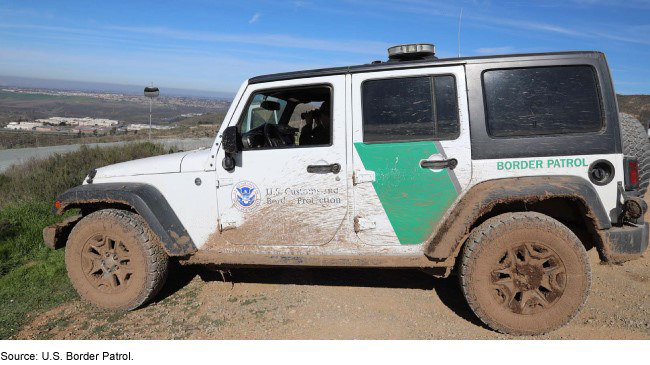Southwest Border: Border Patrol's Missing Migrant Program
Fast Facts
Migrants trying to enter the U.S. illegally along the southwest border risk injury or death by crossing in remote areas. Border Patrol's Missing Migrant Program is intended to identify and help missing or injured migrants.
In our April 2022 report, we recommended improving the data that the program reports to Congress on migrant deaths. Border Patrol has taken some steps since then. For example, officials visited 6 of the 9 border sectors to review their activities and discuss how data is entered into the tracking system.
Border Patrol needs to further ensure that the sectors are collecting and recording available information on migrant deaths.
A Border Patrol Vehicle in San Diego, California

Highlights
What GAO Found
Border Patrol established the Missing Migrant Program to help rescue migrants in distress and reduce migrant deaths along the southwest border. Through this program, Border Patrol coordinates with external entities (e.g., state and local officials) to assist migrants and to recover and identify remains. For example, the agency responds to 9-1-1 calls and other external entity reports of migrants missing or in distress. This coordination includes sharing information obtained from personal effects, fingerprints, and DNA samples. For example, Border Patrol officials at one field location told GAO that a local medical examiner collects fingerprints from deceased individuals who are suspected of being missing migrants. Border Patrol checks these fingerprints against its databases for matching records.
Border Patrol's migrant death data are incomplete and selected external entities collect some data. In April 2022, GAO found that Border Patrol has not collected and recorded, or reported to Congress, complete data on migrant deaths. In particular, GAO found that Border Patrol was not recording all migrant deaths in instances where an external entity first discovers the remains of a deceased migrant. GAO recommended that Border Patrol take steps to ensure it collects and records available information on migrant deaths, including those identified by external entities.
Border Patrol agreed with this recommendation and has taken steps in response. For example, Border Patrol officials told us that in September and October 2022, headquarters officials visited 6 sectors to review program activities at the sector level. During these visits, headquarters officials also met with Missing Migrant Program coordinators to discuss the entry of data into the Border Patrol system of record for migrant deaths. While these are positive steps, to fully address the intent of our recommendation, Border Patrol needs to further ensure that sectors are collecting and recording available information on migrant deaths. In addition, while selected external entities that coordinate with Border Patrol collect some data on migrant deaths, these data vary in how they are collected and used.
Border Patrol has also taken steps to evaluate the Missing Migrant Program. In April 2022, GAO found that Border Patrol collected and reviewed information about program activities; however, it did not have a plan to evaluate the program overall. GAO recommended that Border Patrol develop a plan with time frames to evaluate the program. Border Patrol agreed with GAO's recommendation and has actions underway to address it. For example, the Missing Migrant Program held a meeting in April 2022 where officials established goals and objectives for the program. Among other things, these goals include objectives related to improving data collection and reconciling data with that of external entities. To fully address the intent of GAO's recommendation, Border Patrol should develop a plan for evaluating the program overall.
Why GAO Did This Study
U.S. Customs and Border Protection (CBP), within the Department of Homeland Security, is the lead federal agency responsible for border security. U.S. Border Patrol, within CBP, is responsible for securing the U.S. border between ports of entry to prevent individuals and goods from entering the U.S. illegally. In fiscal year 2021, Border Patrol recorded a record number of migrant deaths—approximately 600—and the rescue of about 13,000 others.
The Missing Persons and Unidentified Remains Act requires CBP to submit annual reports to Congress that include, among other elements, the number and location of unidentified remains found along the southwest border. In response, Border Patrol submitted its report to Congress on March 29, 2022. The Act also includes a provision for GAO to review how CBP collects data on migrant deaths and how CBP works with external entities in cases involving missing migrants or unidentified remains. This report addresses (1) Border Patrol's coordination with external entities in instances of missing migrants, and the recovery and identification of migrant remains; (2) Border Patrol's data on migrant deaths and the extent to which there are available data on migrant deaths from selected external entities; and (3) how Border Patrol evaluates the Missing Migrant Program.
GAO analyzed Border Patrol documentation, and interviewed officials at Border Patrol headquarters, three field locations, and from three external entities. GAO selected the three field locations to reflect a range in the number of reported migrant deaths, types of terrain, and interactions with external entities. GAO selected the three external entities based on location, entity type, and coordination with Border Patrol. This report supplements information and draws from GAO's April 2022 report on the Missing Migrant Program (GAO-22-105053).
For more information, contact Rebecca Gambler at (202) 512-8777 or gamblerr@gao.gov.
